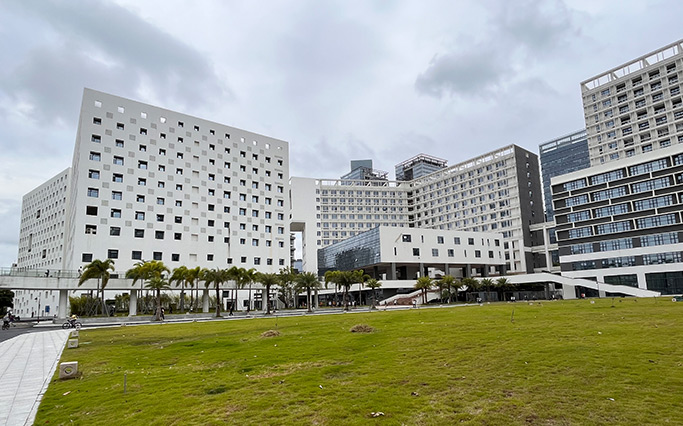
The predecessor of the College of Electronics and Information Engineering at Shenzhen University was the Department of Electronics, which was established in 1983 with the assistance of Tsinghua University. The first department head was Tong Shibai. In 1997, the School of Information Engineering was established, and in January 2019, it merged with the School of Electronic Science and Technology to form the College of Electronics and Information Engineering. The college currently has two primary disciplines: Information and Communication Engineering and Electronic Science and Technology. It also has two doctoral programs: one in Information and Communication Engineering and the other in Electronic Information. Information and Communication Engineering is one of the earliest doctoral programs established at Shenzhen University in 2006. It is a key discipline in Guangdong Province (the highest level in the province), a key discipline for the construction of high-level universities in Guangdong Province, and a key discipline for "Boosting and Reinforcing" in Guangdong Province (with an A+ evaluation during the construction period). In the fourth round of national disciplinary evaluations, Information and Communication Engineering ranked second in Guangdong Province (alongside South China University of Technology), tied for 28th in the country. In the 2020 and 2021 rankings for the Best Subjects in China by RUR, Information and Communication Engineering ranked 13th in the country and second in the province. In the 2022 rankings, it moved up to 13th in the country. The College of Telecommunications had eight faculty members selected for the "Lifetime Scientific Impact Rankings" of the top 2% of scientists globally in 2022, ranking second at the university. In 2021, 21 faculty members were selected for the "Scientific Impact Rankings for 2021" of the top 2% of scientists globally, ranking first at the university. These rankings reflect the college's commitment to excellence...
1983

After years of construction efforts, the college has a number of high-level research platforms, including:Four national-level research platforms: the National Key Laboratory of RF and ISIC (led by Academician Mao Junfa), the ATR Key Laboratory of National Defense Science and Technology (Shenzhen Branch), the Joint Research Center of National Key Laboratory of Experimental Physics and Computing Mathematics, and the National Health Commission's 5G+ Grid Community Intelligent Medical Management Application Demonstration Platform. Nine provincial-level research platforms in Guangdong Province: Guangdong Provincial Laboratory of Digital Creative Technology Engineering (led by Academician Ding Wenhua) and so on. Six key laboratories in Shenzhen: the Key Laboratory of Modern Communication and Information Processing, and so on.

Number of undergraduate students
2358
Number of postgraduate students
1239
Number of doctoral students
70
Employment ratio
95%The college currently has 230 faculty members (including post-doctoral researchers), among whom there are 140 full-time teachers, 27 doctoral supervisors, 34 professors, and 32 associate professors. 94% of the teachers hold a doctoral degree, and about 85% of them have studied abroad at prestigious universities. Among the full-time faculty, there is 1 academician of the Chinese Academy of Sciences, 1 academician of the Chinese Academy of Engineering, 3 recipients of the National Outstanding Youth Fund, 1 national-level outstanding contribution expert, 5 national high-level talents (innovation/entrepreneurship), 2 IEEE Fellows, 4 recipients of the National Excellent Youth Fund, 2 outstanding talents/leadership talents of the Guangdong Province "Special Support Plan", 4 recipients of the Education Ministry's New Century Excellent Talents Support Program, 2 recipients of the Guangdong Province Outstanding Youth Fund, 1 Young Pearl River Scholar, 4 young top talents of the Guangdong Province "Special Support Plan", 2 young talents supported by the China Association for Science and Technology, 4 Pengcheng Scholars, and 6 talents recognized by the central organization, provincial, and university level "Thousand Talents Program", as well as 5 recipients of the State Special Allowance. In addition, distinguished visiting professors include 4 academicians of domestic and foreign academies of sciences/engineering, 3 national outstanding young fund recipients, and 4 IEEE Fellows, etc.
After years of construction efforts, the college has a number of high-level research platforms, including:Four national-level research platforms: the National Key Laboratory of RF and ISIC (led by Academician Mao Junfa), the ATR Key Laboratory of National Defense Science and Technology (Shenzhen Branch), the Joint Research Center of National Key Laboratory of Experimental Physics and Computing Mathematics, and the National Health Commission's 5G+ Grid Community Intelligent Medical Management Application Demonstration Platform. Nine provincial-level research platforms in Guangdong Province: Guangdong Provincial Laboratory of Digital Creative Technology Engineering (led by Academician Ding Wenhua) and so on. Six key laboratories in Shenzhen: the Key Laboratory of Modern Communication and Information Processing, and so on.

In response to major national demands and international academic frontiers, our college has undertaken a number of national key research projects in recent years, including 1 national major project, 1 national outstanding youth fund, 1 national excellent youth fund, and 10 national key projects. In 2021, the college's research funding amounted to 100 million yuan, and it is expected to reach 120 million yuan in 2022. In recent years, the college has won several scientific and technological achievement awards, including 2 first prizes of the Military Science and Technology Progress Award, 1 first prize of the Natural Science Award of the China Computer Federation, 1 first prize of the Technical Invention Award of the China Institute of Communications, 1 first prize of the Technical Invention Award of the Chinese Institute of Electronics, 1 second prize of the Natural Science Award of the Ministry of Education, and 2 second prizes of the Guangdong Science and Technology Progress Award.